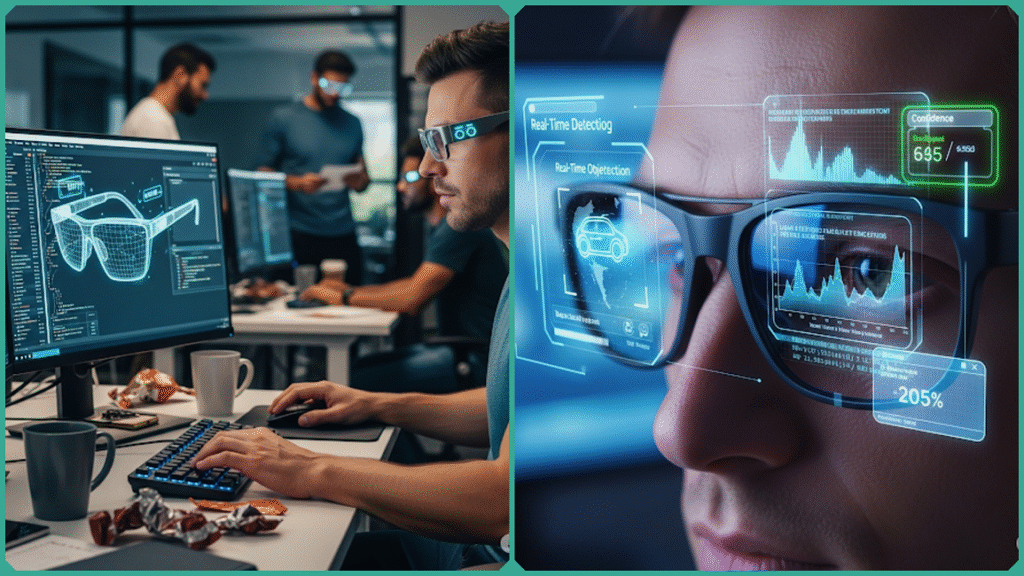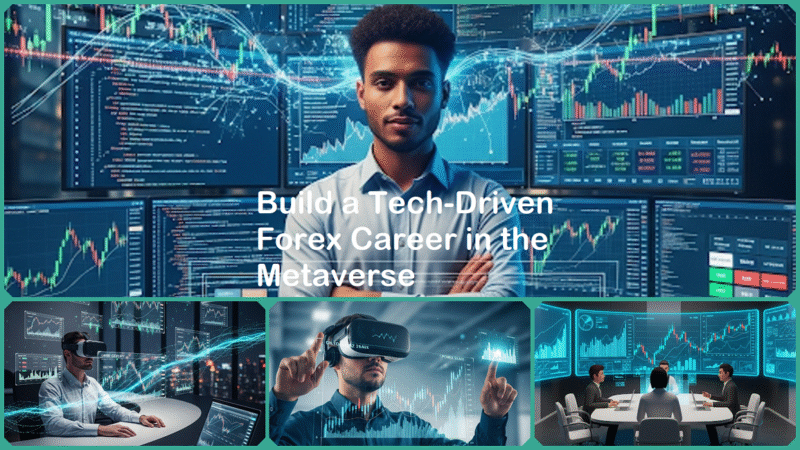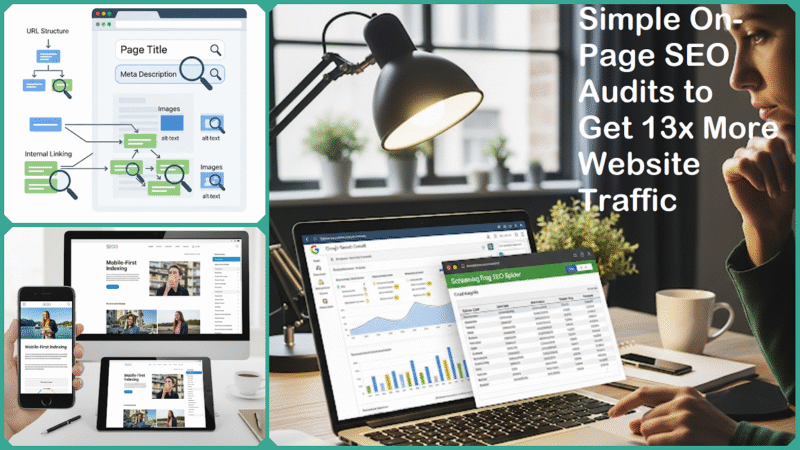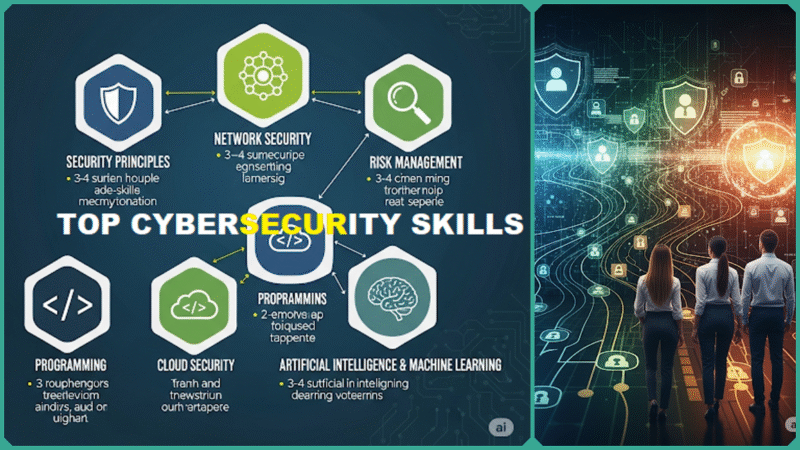How the AI Eyeglasses are Creating New Tech Career Paths
Estimated reading time: 17 minutes
The emergence of AI eyeglasses is transforming not only how we interact with technology but also how tech careers are evolving. These innovative smart wearables, blending artificial intelligence with augmented reality, are opening up dynamic new career opportunities for aspiring professionals, seasoned experts, career changers, and hiring managers alike.
By seamlessly integrating advanced computing power directly into everyday eyewear, AI eyeglasses enable users to effortlessly access a wide range of real-time data, immersive augmented reality overlays, and sophisticated AI-driven insights. This innovative technology transforms ordinary glasses into powerful smart devices that enhance daily experiences and productivity.

As a groundbreaking technology set to disrupt industries ranging from healthcare and manufacturing to education and retail, AI eyeglasses are driving demand for fresh skill sets and roles focused on their creation, implementation, and support. Exploring these emerging career paths is crucial for anyone invested in the future of technology careers.
Key Concepts and Theories Behind AI Eyeglasses
AI eyeglasses incorporate a variety of essential and advanced technologies at their foundation to deliver a smooth, intelligent, and highly immersive user experience. These critical and innovative technologies encompass:
Artificial Intelligence (AI)
Artificial Intelligence serves as the driving force behind these advanced eyeglasses, empowering them to mimic human intelligence in remarkable ways. This technology allows the glasses to independently learn from their environment, solve complex problems, and make informed decisions without human intervention. Key features enabled by AI include;
- Sophisticated voice recognition capabilities that understand and respond to spoken commands
- Natural language processing that allows seamless communication between the user and the device
- Real-time language translations to break down communication barriers instantly
- Adaptive user interactions that personalize the experience based on individual preferences and behaviors
Augmented Reality (AR)
Augmented Reality, commonly known as AR, involves overlaying digital content directly onto the physical world by using displays that are embedded within the lenses of eyeglasses. This innovative technology enables users to view a wide range of digital information, objects, or animations seamlessly integrated into their real-world environment.
By doing so, AR allows users to access and interact with virtual elements without obstructing their view or losing awareness of their actual surroundings. This creates a highly immersive, hands-free interactive experience that enhances how people perceive and engage with their environment in everyday situations.
Computer Vision
Computer vision technology allows the glasses to accurately interpret and respond to the extensive visual data captured through their built-in cameras. This advanced capability includes the recognition of various objects, identification of faces, detection of gestures, and comprehensive spatial mapping of the surrounding environment.
All these functions are crucial for rendering highly precise augmented reality (AR) overlays and facilitating seamless, intuitive interaction between the user and the digital content displayed within their field of view.
On-device AI Processing
AI eyeglasses are equipped with powerful yet compact processors known as System on a Chip (SoC), designed specifically to handle a wide range of AI tasks directly on the device itself. By performing these computations locally, the glasses significantly reduce latency, ensuring that responses and actions occur almost instantaneously.
This local processing also greatly enhances user privacy by minimizing the amount of sensitive data that needs to be transmitted to external cloud servers. Additionally, it helps conserve battery power, allowing for longer usage times without frequent recharging. Overall, this approach provides users with faster, more secure, and highly reliable AI-driven functionalities right at their fingertips.
How These Technologies Work Together:
- Display Technology: Advanced micro-displays, including cutting-edge OLED or micro-OLED panels, are utilized to project vibrant digital images directly onto the lenses through sophisticated waveguide or holographic optical systems. This innovative approach results in exceptionally bright, high-resolution visuals that seamlessly integrate and blend with the wearer’s real-world environment, creating a more immersive and natural augmented reality experience.
- Sensors and Cameras: Multiple advanced sensors, including high-resolution cameras, inertial measurement units such as gyroscopes and accelerometers, depth sensors, and occasionally LiDAR technology, work together to collect comprehensive environmental data. This wide array of sensors enables precise gesture recognition, accurate head movement tracking, and enhanced spatial awareness, allowing the system to interact seamlessly with the surrounding environment.
- AI Software & Connectivity: On-device AI efficiently handles simple tasks such as recognizing voice commands and identifying basic objects with impressive speed and accuracy. However, when it comes to more complex computations and advanced processing needs, cloud-based AI services come into play by enhancing the device’s capabilities through wireless connections like Wi-Fi and Bluetooth. This seamless integration allows devices to perform powerful AI functions, including generating creative suggestions, conducting large-scale data analysis, and supporting sophisticated machine learning models that require extensive computational resources beyond the device’s native capacity.
- User Interaction: Users engage with AI eyeglasses using a variety of methods, including voice commands that allow for seamless communication, touch-sensitive frames that respond to gentle taps or swipes, gesture controls that interpret hand movements, and advanced eye-tracking technology that follows where the user looks. This combination creates a highly intuitive and convenient hands-free interface, enabling effortless and natural interaction with the device in everyday situations.
Applications Enabled by This Convergence
These advanced technologies combined enable AI eyeglasses to provide a wide range of sophisticated features, including real-time language translations that facilitate seamless communication across different languages. They also support gesture recognition, allowing users to control the device through hand movements without the need for any physical contact, enhancing convenience and hygiene.
Additionally, the glasses can offer remote assistance, such as expert help delivered through live video feeds, which is especially useful in professional or technical scenarios. Furthermore, they support interactive training sessions, providing hands-on learning experiences directly through the glasses.
The device also delivers context-aware notifications tailored to the user’s environment and activities, ensuring relevant information is provided at the right time. Lastly, the glasses enhance navigation by overlaying augmented reality directions, making it easier for users to find their way in unfamiliar locations.
In Summary
AI eyeglasses are highly sophisticated smart devices that combine advanced artificial intelligence, augmented reality, computer vision technologies, and powerful on-device processing capabilities into lightweight, comfortable eyewear.
These innovative glasses enable users to experience seamless digital augmentation of their physical surroundings, blending real and virtual elements effortlessly for enhanced interaction and information access throughout the day.
How AI Eyeglasses Are Creating New Tech Career Paths
The rapid rise of AI eyeglasses is significantly driving the development and creation of highly specialized tech career paths that uniquely blend expertise in artificial intelligence, advanced computer vision, cutting-edge hardware innovation, user experience design, and important ethical considerations.
Below is a detailed and comprehensive overview of the most prominent career paths that are directly influenced or enabled by the growing AI eyeglasses industry, reflecting the latest trends, emerging technologies, and the most sought-after skills in demand as of the year 2025:
AI Engineer and Machine Learning Specialist
These skilled professionals are responsible for developing, refining, and optimizing advanced AI models that empower eyeglasses to intelligently interpret and respond to users and their surrounding environments. Their work encompasses a wide range of technologies, including sophisticated computer vision systems, intricate pattern recognition techniques, and adaptive machine learning algorithms.
These technologies enable cutting-edge features such as real-time language translation, personalized virtual assistance, and context-aware interactions. Expertise in programming languages and tools such as Python, TensorFlow, PyTorch, and various deep learning frameworks is crucial for success in this role.
As the AI glasses market continues to expand rapidly, there is an increasing demand for experts who can innovate, improve, and fine-tune these machine learning models to deliver seamless on-device processing as well as cloud-enhanced AI capabilities.
Computer Vision Engineer
Computer vision engineers are experts who specialize in designing and developing advanced software systems that process and interpret visual data captured by the cameras and sensors embedded in smart glasses. Their work is essential for enabling key functionalities such as object recognition, gesture control, and spatial mapping, all of which contribute to creating augmented reality (AR) overlays that are not only seamless but also highly responsive to user interactions.
This specialized knowledge and skill set are becoming increasingly vital and essential as augmented reality (AR) technology continues to rapidly evolve and advance, delivering progressively more immersive, intuitive, and engaging experiences within AI-powered eyewear devices. As these technologies develop, the demand for expertise in this area grows significantly.
Hardware and Firmware Developers
Creating advanced AI eyeglasses requires highly specialized and cutting-edge hardware engineering skills to seamlessly integrate a variety of essential components, such as sensors, microprocessors, batteries, and advanced display technology into designs that are both lightweight and ergonomically comfortable for everyday use.
Firmware developers play a crucial role by writing efficient low-level code that manages and controls these hardware components, ensuring optimal power consumption and peak performance throughout operation. This position demands a unique combination of expertise in embedded systems engineering and a deep understanding of hardware-software co-design principles to deliver a sophisticated and reliable product.
User Experience (UX) Designers and Developers
UX experts are responsible for designing the way users interact with AI glasses, placing a strong emphasis on creating intuitive and seamless hands-free interfaces. These interfaces skillfully integrate advanced technologies such as eye-tracking, voice commands, and gesture recognition to enhance usability.
Their goal is to ensure that the technology remains user-friendly and comfortable for prolonged use, carefully balancing augmented reality (AR) information overlays with clear visibility of the real world to provide an optimal experience.
AI Product Managers and Project Managers
These skilled professionals play a crucial role in coordinating the entire development process of AI eyeglass products, acting as the vital link between engineering teams and various business stakeholders. Their responsibilities encompass aligning the product’s features and functionalities closely with evolving market needs and customer demands.
Additionally, they ensure strict compliance with data privacy regulations and safety standards throughout the development cycle. They also expertly manage project timelines and resources to guarantee smooth and timely product launches, ultimately driving the success of innovative AI eyewear solutions in the competitive market.
AI Ethics and Privacy Specialists
Given that AI eyeglasses continuously collect a wide range of highly sensitive user data, there is an essential and growing need for dedicated ethics and privacy experts. These specialists play a vital role in developing comprehensive policies, closely monitoring compliance with regulatory standards, conducting thorough audits, and ensuring the responsible and ethical use of AI technologies.
Their work places a strong emphasis on fairness, transparency, and accountability in every aspect of AI operations, thereby ensuring the protection of users’ rights and privacy in a comprehensive manner. Additionally, their efforts help shield organizations from potential ethical dilemmas and significant legal risks that could arise, fostering a more trustworthy and responsible use of artificial intelligence technologies.
Technical Trainers and Support Specialists
As AI eyeglasses become increasingly integrated into various industries such as healthcare, manufacturing, and education, trainers and support teams play a crucial role in helping users adopt and fully maximize the benefits of this advanced technology.
These professionals provide comprehensive education and training on how to properly use the devices, assist in troubleshooting any technical issues that may arise, and monitor system performance regularly. Their ongoing support ensures smooth and effective implementation, allowing users to harness the full potential of AI eyeglasses in their respective fields.
Market and Industry Insight (2025)
The AI eyeglasses market has experienced remarkable and rapid expansion, with projections indicating growth reaching into the billions of dollars by 2030. This surge is largely driven by influential companies such as Meta, which currently holds a dominant position with approximately 60-70% of the market share through its popular Ray-Ban AI glasses.
Meanwhile, Apple is also preparing significant product launches that are expected to further accelerate market growth. As this market continues to expand, the demand for highly skilled professionals in areas such as artificial intelligence, augmented reality, advanced hardware design, and the ethical deployment of these technologies is intensifying.
Consequently, this significant growth is actively fostering the development of a robust, vibrant, and dynamic ecosystem that is filled with a wide range of diverse and highly promising career opportunities spanning across multiple sectors and industries.
Skills Across Roles
- Programming Languages: Python, C++, TensorFlow, PyTorch
- AR Development Platforms: Unity, Unreal Engine
- Hardware Knowledge: Embedded Systems, Firmware Programming
- UX: Eye-tracking, Voice UI, Gesture Interface Design
- Compliance: AI Ethics, Data Privacy Regulations
- Soft Skills: Project Management, Communication, Cross-functional Collaboration
This intricate landscape of highly specialized roles guarantees that AI eyeglasses evolve beyond being mere technological novelties or fleeting trends. Instead, they become powerful catalysts that open up a wide array of diverse and meaningful career opportunities across multiple domains.
These opportunities encompass a wide range of roles, from highly technical positions that demand advanced and specialized expertise to essential managerial roles responsible for overseeing the entire project development process and ensuring successful implementation.
Additionally, there are essential ethical oversight roles dedicated to ensuring responsible innovation and addressing societal impacts. Together, these varied roles are vital for fostering the sustainable growth and long-term success of this rapidly emerging and transformative tech sector.
If you are a tech professional or someone looking to change careers and interested in entering this rapidly evolving field, developing strong skills in artificial intelligence, augmented reality, computer vision, and the ethical, responsible use of AI technologies will significantly enhance your chances of securing promising job opportunities. Gaining expertise in these cutting-edge areas will position you advantageously for a wide range of emerging roles within this innovative and dynamic industry.
Industry-Specific Applications and Capabilities of AI Eyeglasses
AI eyeglasses are driving significant innovation and creating tailored skill demands across a wide range of industries and professional fields. These advanced devices are revolutionizing how tasks are performed and data is accessed in real time.
Here is a detailed and comprehensive look at how AI eyeglasses are being applied, as well as the specific skills and expertise required to maximize their potential in key sectors:
Healthcare
In the field of healthcare, AI-powered eyeglasses offer doctors and medical professionals an innovative way to access real-time patient data overlays, including vital signs, diagnostic imaging results, and detailed surgical guides, all displayed directly within their field of vision.
This hands-free technology significantly enhances the ability to maintain focus on the patient while simultaneously receiving essential information, thereby improving the overall accuracy, efficiency, and safety of medical procedures.
The essential and critical skills necessary to effectively and efficiently utilize this advanced and sophisticated technology include:
- Medical informatics to understand and integrate clinical data.
- AR-guided diagnostics for overlaying contextual patient information.
- Familiarity with healthcare compliance and data privacy regulations to manage sensitive patient data securely.
Manufacturing
Manufacturing workers now utilize advanced AI-powered eyeglasses that provide interactive, detailed step-by-step instructions, assist with quality control processes, and enable remote expert assistance in real-time.
These innovative tools significantly boost overall productivity and help minimize errors on the factory floor, ensuring smoother operations and higher standards. Key skills that are essential in this sector include:
- Knowledge of industrial automation systems.
- Understanding of Internet of Things (IoT) integration to connect AI glasses with machinery and sensors.
- Ability to develop or manage AR content that assists workers in complex assembly or maintenance tasks.
Education
Educators increasingly employ advanced AI-powered eyeglasses to create highly immersive and interactive learning environments by incorporating augmented reality overlays. These innovative devices significantly enhance traditional teaching materials and greatly boost student engagement by providing dynamic visual aids and real-time information.
They support a wide range of educational activities, including interactive lessons, virtual lab simulations, and hands-on exploration that deepen understanding and foster active participation. Relevant skills include:
- Instructional design tailored to AR and AI technologies.
- AR content creation for educational materials using platforms like Unity or Unreal Engine.
- Understanding accessibility considerations to ensure the technology benefits diverse learner populations.
Retail
In the retail industry, employees utilize advanced AI-powered eyeglasses to seamlessly access detailed customer profiles, comprehensive inventory data, and sophisticated AI-driven sales scenarios. These innovative tools enable staff to offer a highly personalized shopping experience, significantly enhancing the overall quality of customer service.
Essential skills required in retail include:
- Customer experience management focused on integrating AI insights.
- Proficiency in AI analytics to interpret and act on data signals rapidly.
- Familiarity with inventory and supply chain systems connected to AI eyewear.
Summary of the Industry-Specific Applications and Skills
| Industry | Applications of AI Eyeglasses | Key Skills Required |
|---|---|---|
| Healthcare | Real-time patient data overlays, AR-guided diagnostics | Medical informatics, AR diagnostics, and data privacy |
| Manufacturing | Interactive work instructions, remote expert assistance, and quality control | Industrial automation, IoT integration, AR content |
| Education | Immersive learning, AR-enhanced teaching materials | Instructional design, AR content creation, accessibility |
| Retail | Personalized customer service, inventory insights, and sales assistance | Customer experience, AI analytics, and inventory systems |
The market for AI eyeglasses is expanding at a remarkable and rapid pace, fueling an increasing demand for skilled professionals who possess a unique combination of expertise in artificial intelligence, augmented reality, advanced data analytics, and specialized knowledge tailored to specific industries.
These professionals are essential to fully unlocking and harnessing the vast potential and transformative capabilities of this cutting-edge technology, enabling innovative applications and solutions that can reshape various sectors.
FAQs
What technical skills are essential for working with AI eyeglasses?
Critical technical skills include proficiency in AI and machine learning programming languages and frameworks such as Python, TensorFlow, and PyTorch. Knowledge of computer vision is vital for processing visual data captured by AI eyeglasses. AR development skills using platforms like Unity or Unreal Engine help create immersive user experiences.
Embedded systems programming is needed to work with on-device hardware and firmware. Additionally, expertise in user experience (UX) design and ethical AI practices—such as data privacy and responsible AI use—is highly valued.
Can non-tech professionals transition into AI eyeglasses-related roles?
Career changers can enter AI eyeglasses-related fields by upskilling through targeted courses and bootcamps in AI fundamentals, AR content creation, and device support. Combining industry-specific knowledge with technical training opens doors to roles in training, support, product management, or ethical compliance. Practical projects and certifications also strengthen candidates’ qualifications without necessarily requiring formal degrees.
What is the job outlook for AI eyeglass-related careers?
The job outlook is strongly positive. AI-related roles, including those relevant to AI eyeglasses, are growing rapidly due to increasing market demand. Salaries vary by specialization and experience but typically range from approximately $80,000 for entry-level roles to more than $200,000 for senior AI engineers and specialists. The growing wearable AI market is expected to expand opportunities significantly in the coming years.
Are formal degrees necessary for entering these careers?
While many AI eyeglass-related roles benefit from degrees in computer science, artificial intelligence, or related fields, formal degrees are not always mandatory. Many professionals successfully enter this field via certifications, coding bootcamps, and accumulating relevant project experience. Hands-on skills and continuous learning are often prioritized by employers alongside or even over traditional degrees.
How can hiring managers find talent for AI eyeglass projects?
Hiring managers should look for candidates with hybrid skill sets combining AI, AR development, hardware understanding, and UX design. Collaborating with educational institutions, offering internships, and on-the-job training programs can help develop suitable talent. Using specialized job platforms focusing on AI and emerging tech can improve talent sourcing effectiveness.
In Conclusion
AI eyeglasses represent a confluence of groundbreaking technologies that are not only changing how we interact with the world but also how careers in technology evolve. For aspiring professionals, established tech experts, and career changers, the expanding ecosystem of AI eyeglasses offers a broad spectrum of promising and high-growth opportunities.
By embracing new skills in AI, machine learning, computer vision, AR, and ethical technology use, individuals can position themselves at the forefront of this exciting technological wave. To stay competitive and capitalize on these emerging opportunities, tech professionals should actively pursue education in AI and AR, seek hands-on experience, and monitor industry trends closely.
Hiring managers must adapt recruitment strategies to identify versatile talent capable of navigating this intersection of AI and wearable tech. Embracing AI eyeglasses means embracing the future—where technology empowers us seamlessly, and careers are defined by innovation and creativity in solving tomorrow’s challenges today.
Discover more from Skill to Grow
Subscribe to get the latest posts sent to your email.






